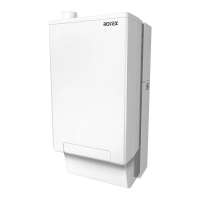6 Preparation
Installer reference guide
17
RVLQ05+08CAV4 + RHYHBH05AA + RHYHBH/X08AA +
RHYKOMB33AA
ROTEX HPU hybrid
4P355635-1 – 2013.05
▪ For safety reasons, it is NOT allowed to add any kind of glycol to
the water circuit.
▪ To avoid stagnation of water, it is important that the storage
capacity of the domestic hot water tank meets the daily
consumption of domestic hot water.
In cases where during longer periods of time there is no
consumption of hot water, the equipment must be flushed with
fresh water before usage.
The disinfection function provided on the equipment is specified in
the operation manual of the indoor unit.
▪ It is recommended to avoid long runs of piping between the
domestic hot water tank and the hot water end point (shower,
bath,…) and to avoid dead ends.
▪ The installation must be in compliance with the applicable
legislation and may require additional hygienic installation
measures.
▪ In accordance with the applicable legislation, it may be necessary
to install thermostatic mixing valves.
▪ Immediately after installation, the domestic hot water tank must be
flushed with fresh water. This procedure must be repeated at least
once a day the first 5 consecutive days after installation.
▪ In accordance with the applicable legislation, it may be required to
connect a recirculation pump in between the hot water end point
and the recirculation connection of the domestic hot water tank.
c
d
ab
a
Recirculation connection
b
Hot water connection
c
Shower
d
Recirculation pump
6.3.2 Formula to calculate the expansion vessel
pre-pressure
The pre-pressure (Pg) of the vessel depends on the installation
height difference (H):
Pg=0.3+(H/10) (bar)
6.3.3 To check the water volume
The indoor unit has an expansion vessel of 10 litre with a factory set
pre-pressure of 1 bar.
To make sure that the unit operates properly:
▪ You must check the minimum and maximum water volume.
▪ You might need to adjust the pre-pressure of the expansion
vessel.
Minimum water volume
Check that the total water volume in the installation is minimum
13.5 liter, the internal water volume of the indoor unit NOT included.
INFORMATION
In critical processes, or in rooms with a high heat load,
extra water might be required.
NOTICE
When circulation in each space heating loop is controlled
by remotely controlled valves, it is important that the
minimum water volume is guaranteed, even if all of the
valves are closed.
RAD1 RAD2 RAD3
T
95°C
a b d e
h
c f
g
a
Outdoor unit
b
Indoor unit
c
Heat exchanger
d
Backup heater
e
Pump
f
Shut-off valve
g
Collector (field supply)
h
By-pass valve (field supply)
RAD1…3
Radiator (field supply)
T1...3
Individual room thermostat (optional)
M1...3
Individual motorised valve to control loop FHL1...3
(field supply)
Maximum water volume
Use the following graph to determine the maximum water volume for
the calculated pre-pressure.
50
0.3
0.4
0.6
0.8
1
1.2
1.4
1.6
1.8
2
2.2
2.4
2.6
100 150 200 250 300 350 400 4500
a
b
a
Pre-pressure (bar)
b
Maximum water volume (l)
Maximum leaving water temperature of 55°C for
underfloor heating applications
Maximum leaving water temperature of 80°C for
radiator applications

